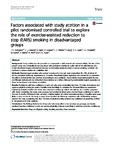Factors associated with study attrition in a pilot randomised controlled trial to explore the role of exercise-assisted reduction to stop (EARS) smoking in disadvantaged groups
| dc.contributor.author | Panda, Asim | |
| dc.contributor.author | Greaves, CJ | |
| dc.contributor.author | Ayres, Richard | |
| dc.contributor.author | Aveyard, P | |
| dc.contributor.author | Warren, FC | |
| dc.contributor.author | Byng, Richard | |
| dc.contributor.author | Taylor, RS | |
| dc.contributor.author | Campbell, JL | |
| dc.contributor.author | Ussher, M | |
| dc.contributor.author | Michie, S | |
| dc.contributor.author | West, R | |
| dc.contributor.author | Taylor, Adrian | |
| dc.date.accessioned | 2017-01-05T10:02:47Z | |
| dc.date.available | 2017-01-05T10:02:47Z | |
| dc.date.issued | 2016-12 | |
| dc.identifier.issn | 1745-6215 | |
| dc.identifier.issn | 1745-6215 | |
| dc.identifier.other | 524 | |
| dc.identifier.uri | http://hdl.handle.net/10026.1/8195 | |
| dc.description.abstract |
BACKGROUND: Study attrition has the potential to compromise a trial's internal and external validity. The aim of the present study was to identify factors associated with participant attrition in a pilot trial of the effectiveness of a novel behavioural support intervention focused on increasing physical activity to reduce smoking, to inform the methods to reduce attrition in a definitive trial. METHODS: Disadvantaged smokers who wanted to reduce but not quit were randomised (N = 99), of whom 61 (62 %) completed follow-up assessments at 16 weeks. Univariable logistic regression was conducted to determine the effects of intervention arm, method of recruitment, and participant characteristics (sociodemographic factors, and lifestyle, behavioural and attitudinal characteristics) on attrition, followed by multivariable logistic regression on those factors found to be related to attrition. RESULTS: Participants with low confidence to quit, and who were undertaking less than 150 mins of moderate and vigorous physical activity per week at baseline were less likely to complete the 16-week follow-up assessment. Exploratory analysis revealed that those who were lost to follow-up early in the trial (i.e., by 4 weeks), compared with those completing the study, were younger, had smoked for fewer years and had lower confidence to quit in the next 6 months. Participants who recorded a higher expired air carbon monoxide reading at baseline were more likely to drop out late in the study, as were those recruited via follow-up telephone calls. Multivariable analyses showed that only completing less than 150 mins of physical activity retained any confidence in predicting attrition in the presence of other variables. CONCLUSIONS: The findings indicate that those who take more effort to be recruited, are younger, are heavier smokers, have less confidence to quit, and are less physically active are more likely to withdraw or be lost to follow-up. | |
| dc.format.extent | 524- | |
| dc.format.medium | Electronic | |
| dc.language | en | |
| dc.language.iso | en | |
| dc.publisher | Springer Science and Business Media LLC | |
| dc.subject | Retention | |
| dc.subject | Drop out | |
| dc.subject | Physical activity | |
| dc.subject | Smoking reduction | |
| dc.subject | Harm reduction | |
| dc.title | Factors associated with study attrition in a pilot randomised controlled trial to explore the role of exercise-assisted reduction to stop (EARS) smoking in disadvantaged groups | |
| dc.type | journal-article | |
| dc.type | Journal Article | |
| dc.type | Multicenter Study | |
| dc.type | Randomized Controlled Trial | |
| dc.type | Research Support, Non-U.S. Gov't | |
| plymouth.author-url | https://www.webofscience.com/api/gateway?GWVersion=2&SrcApp=PARTNER_APP&SrcAuth=LinksAMR&KeyUT=WOS:000386736200002&DestLinkType=FullRecord&DestApp=ALL_WOS&UsrCustomerID=11bb513d99f797142bcfeffcc58ea008 | |
| plymouth.issue | 1 | |
| plymouth.volume | 17 | |
| plymouth.publication-status | Published | |
| plymouth.journal | Trials | |
| dc.identifier.doi | 10.1186/s13063-016-1641-5 | |
| plymouth.organisational-group | /Plymouth | |
| plymouth.organisational-group | /Plymouth/Faculty of Health | |
| plymouth.organisational-group | /Plymouth/Faculty of Health/Peninsula Medical School | |
| plymouth.organisational-group | /Plymouth/REF 2021 Researchers by UoA | |
| plymouth.organisational-group | /Plymouth/REF 2021 Researchers by UoA/UoA03 Allied Health Professions, Dentistry, Nursing and Pharmacy | |
| plymouth.organisational-group | /Plymouth/Research Groups | |
| plymouth.organisational-group | /Plymouth/Research Groups/FoH - Community and Primary Care | |
| plymouth.organisational-group | /Plymouth/Research Groups/Institute of Health and Community | |
| plymouth.organisational-group | /Plymouth/Research Groups/Institute of Translational and Stratified Medicine (ITSMED) | |
| plymouth.organisational-group | /Plymouth/Research Groups/Institute of Translational and Stratified Medicine (ITSMED)/CCT&PS | |
| plymouth.organisational-group | /Plymouth/Research Groups/Plymouth Institute of Health and Care Research (PIHR) | |
| plymouth.organisational-group | /Plymouth/Users by role | |
| plymouth.organisational-group | /Plymouth/Users by role/Academics | |
| plymouth.organisational-group | /Plymouth/Users by role/Researchers in ResearchFish submission | |
| dc.publisher.place | England | |
| dcterms.dateAccepted | 2016-10-06 | |
| dc.identifier.eissn | 1745-6215 | |
| dc.rights.embargoperiod | Not known | |
| rioxxterms.versionofrecord | 10.1186/s13063-016-1641-5 | |
| rioxxterms.licenseref.uri | http://www.rioxx.net/licenses/all-rights-reserved | |
| rioxxterms.licenseref.startdate | 2016-12 | |
| rioxxterms.type | Journal Article/Review | |
| plymouth.oa-location | https://trialsjournal.biomedcentral.com/articles/10.1186/s13063-016-1641-5 |


